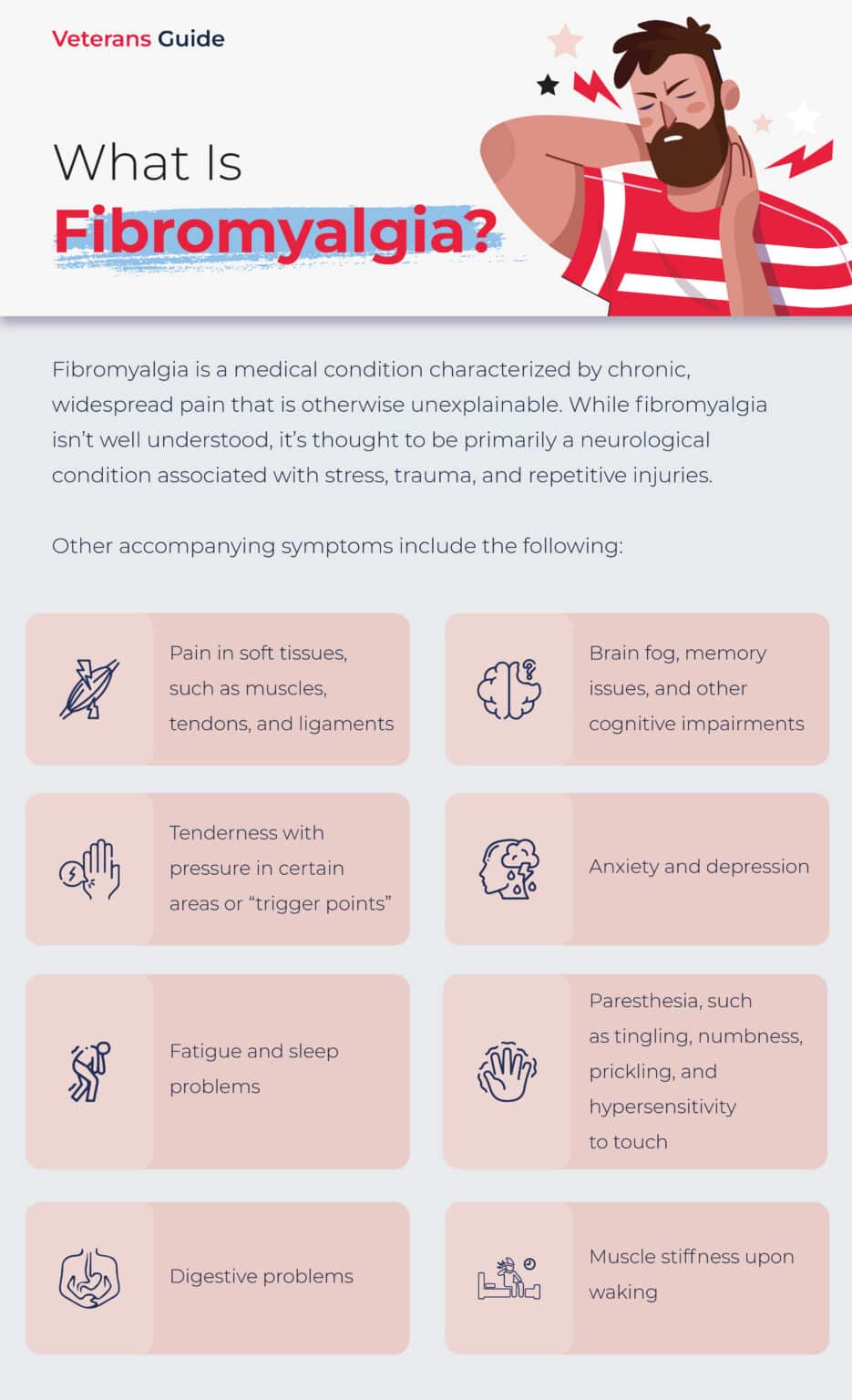VA Disability Rating for Fibromyalgia
The VA gives disability ratings for fibromyalgia of 40%, 20% and 10% based on how severe the symptoms are. If you can manage your symptoms with ongoing medication, you get a 10% rating. If your symptoms come and go but happen more than 1/3 of the time, you get a 20% rating. If your symptoms are constant or almost constant and hard to treat, you get a 40% rating.
As a veteran, you have sacrificed a great deal in service to our country. You put your life on the line, and your body may now be paying the price with disabling conditions that could affect your livelihood and quality of life. You shouldn’t have to pay the financial price for a disability that arose from your military service.
Fibromyalgia is common among veterans, particularly those with higher risk factors and service in the Gulf War. If you’re a veteran suffering from fibromyalgia, you could be entitled to benefits through the U.S. Department of Veterans Affairs. The amount of your monthly disability payment depends on the disability rating you receive. The VA disability rating for fibromyalgia is based on the severity of your condition, ranging from 10 percent to 40 percent.
At Veterans Guide, we provide advocacy and guidance for veterans seeking VA disability benefits, including those with fibromyalgia.

Veterans and Fibromyalgia
The VA recognizes fibromyalgia as a disability. Veterans can qualify for benefits when they meet certain criteria.
What Is Fibromyalgia?
Fibromyalgia is a medical condition characterized by chronic, widespread pain that is otherwise unexplainable. While fibromyalgia isn’t well understood, it’s thought to be primarily a neurological condition associated with stress, trauma, and repetitive injuries.
There isn’t a lab test or imaging for diagnosing fibromyalgia. Instead, health care providers diagnose the condition based on the primary symptom of widespread musculoskeletal pain. Other accompanying symptoms include the following:
- Pain in soft tissues, such as muscles, tendons, and ligaments
- Tenderness with pressure in certain areas or “trigger points”
- Fatigue and sleep problems
- Chronic headaches
- Digestive problems
- Brain fog, memory issues, and other cognitive impairments
- Anxiety and depression
- Paresthesia, such as tingling, numbness, prickling, and hypersensitivity to touch
- Muscle stiffness upon waking
For a fibromyalgia diagnosis, the pain must last longer than three months and have no other explainable cause. It must affect both the upper and lower portions of the body.
Veteran Risk Factors for Fibromyalgia
An important study found that Gulf War veterans are much more likely to experience fibromyalgia than the general population. The VA has accordingly recognized fibromyalgia as a presumptive disease for Gulf War veterans if they have suffered from it for six months or longer. This presumption may entitle a veteran to disability benefits.
Other risk factors for fibromyalgia include:
- Chronic exposure to stressful conditions
- Post-traumatic stress disorder
- Older age
- Underlying rheumatoid arthritis or lupus
- Family history of fibromyalgia
- History of viral infections
- Obesity
Additionally, female veterans are more likely to develop fibromyalgia than males, likely due to hormonal factors.
How Does the VA Rate Fibromyalgia?
The VA uses a disability rating system to determine the amount of veterans’ monthly disability payments. The rating system is based on the type and severity of their disabling condition.
The ratings for fibromyalgia are located in Title 38 of the Code of Federal Regulations, § 4.71a, under diagnostic code 5025. They range from 10 to 40 percent disabled. The maximum disability rating for fibromyalgia is 40 percent.
The ratings break down as follows:
- 10 percent for symptoms that are manageable with continuous medication
- 20 percent for symptoms that come and go but are present at least 34 percent of the time
- 40 percent for constant or near-constant symptoms that are resistant to treatment
TDIU and Fibromyalgia
Veterans with fibromyalgia may be eligible for Total Disability based on Individual Unemployability (TDIU) benefits if their condition makes them unable to do any work. TDIU benefits are equivalent to a 100 percent disability rating.
To get TDIU benefits for fibromyalgia, you must have one or more secondary conditions with a combined rating of at least 70 percent. One of those secondary conditions must be rated at least 40 percent.
Additionally, you must be unable to hold down a steady job because of your disabilities. You will need to submit medical evidence showing that your fibromyalgia and other qualifying disabilities prevent you from working full-time, considering your work training and experience.
Fibromyalgia as a Secondary Disability
In most cases, fibromyalgia is a primary condition, meaning it hasn’t developed due to another underlying medical condition. Sometimes, however, it can develop secondary to other conditions, such as the following:
- Post-traumatic stress disorder
- Significant injuries, particularly to the neck
- Surgeries, particularly in the spine and upper back
- Ankylosing spondylitis, a chronic inflammatory condition
- Inflammatory arthritis
- Chronic Lyme disease
If you have another primary disabling condition that qualifies you for VA benefits, you can qualify for additional benefits with fibromyalgia as a secondary disability. You can combine disability ratings up to a maximum of 100 percent.
Conditions Secondary to Fibromyalgia
Fibromyalgia may also come with secondary conditions that qualify for disability ratings. Common conditions that co-occur with or arise from fibromyalgia include the following:
- Post-traumatic stress disorder
- Chronic fatigue syndrome
- Irritable bowel syndrome
- Migraines
- Interstitial cystitis
- Anxiety
- Depression
- Raynaud’s phenomenon
As with secondary fibromyalgia, you can combine disability ratings for primary fibromyalgia and other qualifying disabling conditions.
Fibromyalgia as a Presumptive Condition for Gulf War Veterans
To receive disability benefits through the VA, veterans must generally prove a connection between their condition and their military service. However, some conditions are “presumptive conditions” for certain veterans. The VA will presume that the disabling condition arose due to military service, provided it meets certain criteria. Those criteria differ for each condition.
The VA has deemed fibromyalgia a presumptive condition for veterans who served in the Gulf War. Their fibromyalgia must have developed either during their tour of active duty or any time after, up until December 31, 2026.
The Gulf War refers to military operations in Southwest Asia and the Middle East from 1990 onward, including the following:
- 1991 Gulf War
- The War in Afghanistan
- Operation New Dawn
- Operation Iraqi Freedom
Southwest Asia includes Afghanistan, Iraq, Saudi Arabia, Kuwait, and many other nations.
- Post Traumatic Stress Disorder
- Chronic Adjustment Disorder
- Major Depressive Disorder
- Hearing Loss
- Nerve and Neurological Damage
- Skin Conditions
- Musculoskeletal Injuries
- Respiratory Conditions and Asthma
- Gastrointestinal Problems
- Heart Disease
- Genitourinary Conditions
- Eye Conditions
- Dental Conditions
- Endocrine Disorders
- Gynecological Conditions
- Hemic and Lymphatic Conditions
- Infectious Diseases and Autoimmune Disorders
How To Obtain VA Disability Compensation for Fibromyalgia?
To obtain VA disability compensation for fibromyalgia, you must apply for VA benefits online. You can also file by mail or in person at a regional VA office.
As part of the application process, you will need to include evidence and supporting documentation, such as the following:
- Your military discharge papers
- Your medical records showing the fibromyalgia diagnosis and its severity
If you’re applying for fibromyalgia benefits as a Gulf War veteran, you must also provide evidence that you served in the Gulf War. If you didn’t serve in the eligible theater of military operations, you must provide evidence showing that your military service caused or worsened your fibromyalgia.
In some cases, the VA may request that you undergo a medical exam—known as a C&P exam—at a VA medical center to verify your claim. The VA will only request a C&P exam if they need more evidence to verify your claim or determine your disability rating. Failure to show up for a C&P exam could jeopardize your claim.
Pursuing disability benefits can be intimidating and confusing. At Veterans Guide, we help veterans make sense of the process. Those seeking more information on VA disability ratings for fibromyalgia can get help online.



